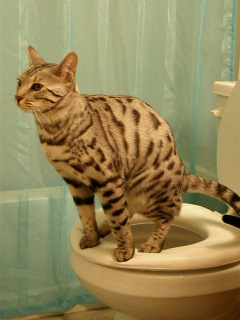Potential Risks of Flushing Cat Poop Down Your Toilet - Advice for Better Disposal
Potential Risks of Flushing Cat Poop Down Your Toilet - Advice for Better Disposal
Blog Article
This post down below about How to Dispose of Cat Poop and Litter Without Plastic Bags is particularly attention-grabbing. You should take a peek.

Intro
As cat owners, it's important to be mindful of how we deal with our feline pals' waste. While it might seem hassle-free to flush feline poop down the toilet, this practice can have detrimental repercussions for both the setting and human health.
Ecological Impact
Flushing feline poop introduces harmful microorganisms and bloodsuckers into the water system, presenting a significant danger to marine ecosystems. These pollutants can adversely impact marine life and concession water high quality.
Wellness Risks
In addition to environmental issues, purging pet cat waste can also position health and wellness threats to human beings. Feline feces might contain Toxoplasma gondii, a parasite that can create toxoplasmosis-- a possibly severe disease, especially for expectant females and individuals with damaged immune systems.
Alternatives to Flushing
The good news is, there are more secure and more accountable methods to deal with feline poop. Take into consideration the complying with choices:
1. Scoop and Dispose in Trash
One of the most usual approach of throwing away feline poop is to scoop it right into an eco-friendly bag and throw it in the trash. Make sure to make use of a specialized clutter inside story and take care of the waste promptly.
2. Use Biodegradable Litter
Choose naturally degradable cat litter made from materials such as corn or wheat. These litters are environmentally friendly and can be safely taken care of in the garbage.
3. Hide in the Yard
If you have a yard, think about burying cat waste in a designated area far from vegetable gardens and water sources. Be sure to dig deep adequate to stop contamination of groundwater.
4. Mount a Pet Waste Disposal System
Purchase a family pet waste disposal system specifically designed for pet cat waste. These systems utilize enzymes to break down the waste, lowering smell and ecological effect.
Conclusion
Liable pet dog possession prolongs past offering food and sanctuary-- it likewise entails correct waste monitoring. By refraining from flushing feline poop down the toilet and opting for alternate disposal techniques, we can minimize our ecological footprint and protect human wellness.
Why Can’t I Flush Cat Poop?
It Spreads a Parasite
Cats are frequently infected with a parasite called toxoplasma gondii. The parasite causes an infection called toxoplasmosis. It is usually harmless to cats. The parasite only uses cat poop as a host for its eggs. Otherwise, the cat’s immune system usually keeps the infection at low enough levels to maintain its own health. But it does not stop the develop of eggs. These eggs are tiny and surprisingly tough. They may survive for a year before they begin to grow. But that’s the problem.
Our wastewater system is not designed to deal with toxoplasmosis eggs. Instead, most eggs will flush from your toilet into sewers and wastewater management plants. After the sewage is treated for many other harmful things in it, it is typically released into local rivers, lakes, or oceans. Here, the toxoplasmosis eggs can find new hosts, including starfish, crabs, otters, and many other wildlife. For many, this is a significant risk to their health. Toxoplasmosis can also end up infecting water sources that are important for agriculture, which means our deer, pigs, and sheep can get infected too.
Is There Risk to Humans?
There can be a risk to human life from flushing cat poop down the toilet. If you do so, the parasites from your cat’s poop can end up in shellfish, game animals, or livestock. If this meat is then served raw or undercooked, the people who eat it can get sick.
In fact, according to the CDC, 40 million people in the United States are infected with toxoplasma gondii. They get it from exposure to infected seafood, or from some kind of cat poop contamination, like drinking from a stream that is contaminated or touching anything that has come into contact with cat poop. That includes just cleaning a cat litter box.
Most people who get infected with these parasites will not develop any symptoms. However, for pregnant women or for those with compromised immune systems, the parasite can cause severe health problems.
How to Handle Cat Poop
The best way to handle cat poop is actually to clean the box more often. The eggs that the parasite sheds will not become active until one to five days after the cat poops. That means that if you clean daily, you’re much less likely to come into direct contact with infectious eggs.
That said, always dispose of cat poop in the garbage and not down the toilet. Wash your hands before and after you clean the litter box, and bring the bag of poop right outside to your garbage bins.
https://trenchlesssolutionsusa.com/why-cant-i-flush-cat-poop/

I hope you liked our article on How to Dispose of Cat Poop and Litter Without Plastic Bags. Thanks for taking the time to read through our article. Do you know about somebody who is sincerely interested in Can You Flush Cat Poop Down The Toilet?? Be sure promote it. We appreciate reading our article about Can You Flush Cat Poop Down The Toilet?.
Call Today Report this page